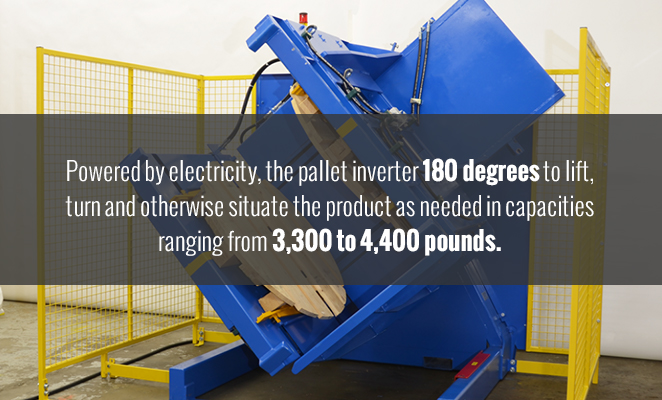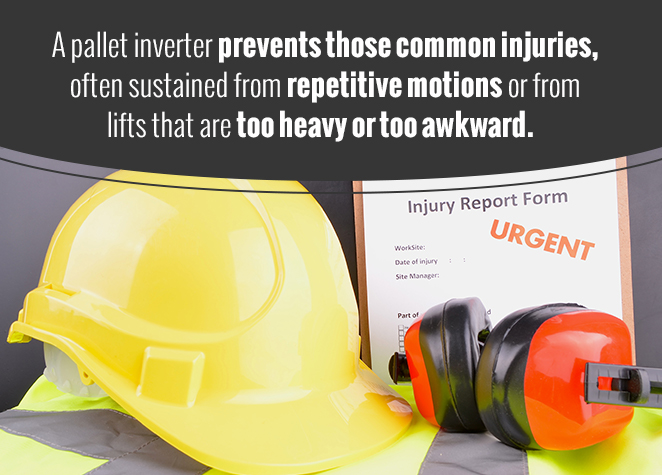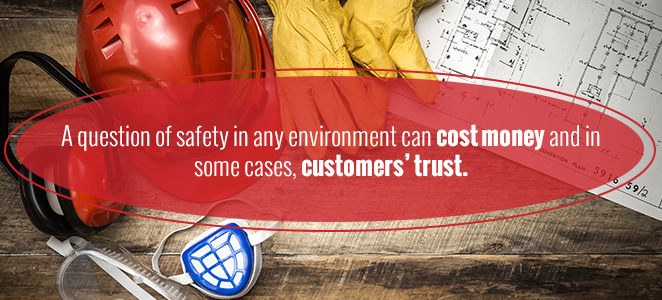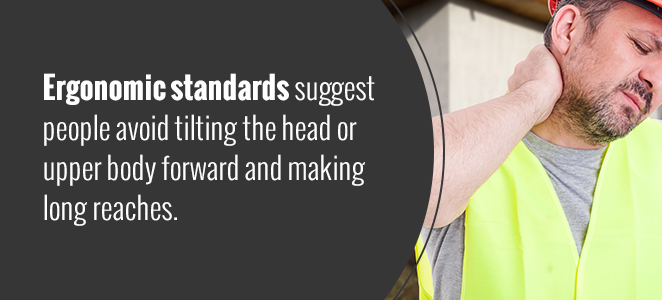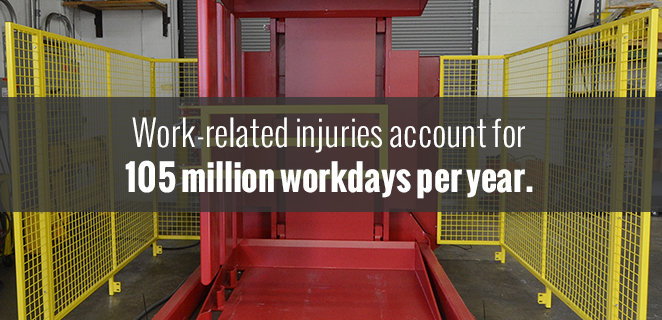Pallet Inverter Safety Tips

The billions and maybe trillions of movements workers make each day to transport and process the products of business are exactly why pallet inverters prove useful, functional and beneficial to the bottom line. They create efficiency and safety.
Pallet inverters handle and reorient product loads of all different sizes and weights, and they enable workers to easily manipulate pallets of boxes, cartons, drums and other containers.
At Cherry’s Industrial Equipment, we’re glad to answer your questions about pallet inverters and how to use them in a way that benefits your day-to-day business operations.
What Is a Pallet Inverter?
A pallet inverter might be a freestanding piece of equipment, or it could be a component within a larger material-handling system.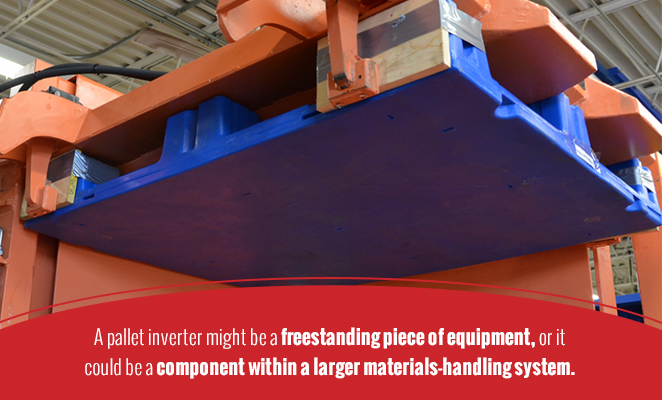 It rotates or tilts pallets at one or several parts of the loading and transport process. A pallet inverter’s main purpose is to handle materials in an ergonomically correct way.
It rotates or tilts pallets at one or several parts of the loading and transport process. A pallet inverter’s main purpose is to handle materials in an ergonomically correct way.
What Is the Pallet Inverter’s Range of Capabilities?
Most pallet inverters have a lift capacity in the neighborhood of 4,400 pounds, with clamp widths ranging from a narrow 23 inches to a maximum jaw-opening width of 110 inches. The pallet inverters available through Cherry’s Industrial make a full rotation in an average of about 17 seconds.
Powered by electricity, the pallet inverter rotates up to 180 degrees to lift, turn and otherwise situate the product as needed in capacities ranging from 3,300 to 4,400 pounds.
A pallet inverter typically has one or multiple clamps that secure the load with programmable pressure, which prevents damage. The name “pallet inverter” does not mean the machine’s uses are exclusively limited to loads on a pallet, since some are drums, cartons, boxes or other containers.
Some inverters have a movable clamp at either end of the load, and some at only one end. The pressure exerted as the machine clamps is programmable and adjustable, which most businesses find useful in preventing damage to containers. The setup also allows for the manipulation of loads that may not be perfectly square, such as barrels, or other materials not delivered on a pallet.
Several choices for side-guard protection and floor-guard configurations help to further customize the pallet-inverter capabilities to secure and turn loads of all shapes and sizes. Each pallet inverter is designed to meet pallet jacks and forklifts at ground level, then hoist the load to an ergonomically correct position for pallet removal or other load manipulation. More pallet-inverter features, such as rollers in the corner and pallet grabbers, can add even more ease, speed and safety to the process of removing and inserting items.
Depending on the model, the pallet inverter usually works via button control. The controller may have anywhere from one to six buttons, which are typically on a hanging cord or mounted to a pedestal. The push-buttons make operation simple and easy, which is also conducive to safe pallet-inverter use.
Who Uses Pallet Inverters and Why?
Uses for pallet inverters vary across multiple industries, including:
- Automotive
- Beverage
- Construction
- Grocery
- Food service
- Landscape and lawn
- Manufacturing
- Publishing
- Retailers
- Warehousing
Companies often need to remove the in-shipment pallets or spacers between containers or insert them before shipment. Many facilities remove or swap the transport pallets for something lighter or smaller and some need to keep the product in sequential order.
Safe use of the pallet inverter is essential to realizing all its possible benefits and advantages.
Why Are Pallet Inverters Beneficial?
The main advantages of pallet inverters are that they lift, turn and orient loads more efficiently and safely than manual labor. In an example of frozen foods’ spacer removal, a pallet inverter makes the handling process up to 90 percent faster than if done by hand.
Each industry prioritizes differently the benefits pallet inverters bring to business:
- Enhance safety
- Cut labor costs
- Increase job efficiency/per-hour rate of pallet handling
- Adjust to a range of load sizes, shapes and heights
- Feature accessories such as pallet grippers
- Adapt to specialty jobs with such options as side support, gravity-assisted movements, single- and dual-clamp, narrow and compact loads, easy cleaning and maintenance
- Prevent accidents and injury
- Produce consistent, precise results
- Hold loads in firmly with hydraulic pressure
- Rollers ease loading and unloading
Pallet-Inverter Safety Is Paramount
Questions about pallet-inverter safety are the most important ones to ask. The equipment is intended to be a safety and efficiency enhancement, but can quickly become a safety risk if used incorrectly.
-
What Pallet-Inverter Safety Tips Should I Know?
From floor markings to personnel training, each aspect of pallet-inverter safety is essential to achieving the benefits expected from the equipment.
The great news is that when used correctly, pallet inverters eliminate much of the risk of injury, accidents, damaged products, inconsistency and all the headaches that come with those circumstances. Pallet inverters are used to help move loads, and one of the top advantages of using them is how they eliminate work that commonly causes injury.
For example, load-transfer work, in general, tends to stress especially the arms, legs, back and shoulders of humans. A pallet inverter prevents those common injuries, often sustained from repetitive motions or from lifts that are too heavy or too awkward.
Each business owner or manager could tell the horror stories of their industry about how many people become injured or even die. The U.S. Department of Labor’s Bureau of Labor Statistics keeps track of industry-specific injury and fatality data. These statistics speak to the need for and benefit of pallet inverters.
For one example, food manufacturing showed an incidence rate of 71.2 per 100 workers, the highest in the manufacturing category. The injury and fatality statistics of any industry can be sobering, especially in cases that directly affect your company, your workers or your bottom line.
Injury cases can lead to lawsuits, liability, loss of production, degraded morale and other negative impacts. While a pallet inverter does not provide absolute safety throughout a plant or workplace, it can be an important tool that creates more positive impact for workers.
An awareness of the dangers associated with equipment use is the first among many tips for top-notch safety around pallet inverters.
- Know the machine: Familiarize all operators with how the equipment works and moves, including floor guards and other parts that fit flush, as well as clamps that exert pressure and all moving parts.
- Train many, versus few: It may seem like an ambitious endeavor to train anyone and everyone on how to use the pallet inverter and about its potential hazards, but the more you can familiarize your staff with the equipment, the less likely you’ll have accidents due to inexperience or ignorance.
- Define the area: Use safety tape, reflective markings, cones and other attention-getters to mark off and call attention to the clear zone of a pallet inverter. Operators and other employees should have no trouble discerning where the clear-and-safe zone is.
- Maintain the equipment: Pallet inverters are relatively low-maintenance, but like any other machine with working parts, they do need to be inspected, cleaned and serviced regularly. The checks help equipment yield optimum production and safety results.
- >Read and relay the stories: The Department of Labor tracks accident reports, like one worker who sustained two broken ribs and a broken leg after sitting on an inverter with the operation switch in manual mode. The worker got caught and slammed against a hoist when an employee down the line turned on a conveyor that put the sitting employee in motion.
-
What Training Should Pallet-Inverter Operators Have?
Most owners and managers want a safe workplace with good conditions, and the Occupational Safety and Health Administration (OSHA) requires general workplace safety. The agency can pretty much show up anytime, announced or unannounced, to inspect, observe and ask questions. Inspectors’ presence can prompt everything from a headache and hassle to major fines and other penalties. For example, each instance of an unlicensed forklift driver can add up quickly.
The Department of Labor categorizes powered industrial trucks into seven classes, each of which has a few machines in its subset. OSHA requires powered-truck and many types of heavy-machine operators to undergo training and demonstrate their skill to earn a certification for the equipment they’ll be driving or operating. The agency’s role is to ensure a safe environment in workplaces, so in essence, it is there to help.
A question of safety in any environment can cost money — and, in some cases, customers’ trust. The training people undergo to drive or run a piece of heavy equipment teaches them much more than the specifics of a certain machine. Equipment training communicates lessons on load physics, clearance, visibility, correct procedures and general machine safety.
In most cases where a pallet inverter is used, the people using it probably also operate a forklift to load it and unload it, so they are certified and have had safety training. In cases where a person only operates the pallet inverter, essentially pushing the button and removing or changing the pallets, they would still benefit from full safety training. It helps them be aware of hazards and be better able to achieve safe operation of the machine and its interaction with other equipment.
While OSHA might not come in asking to see the pallet-inverter operator’s license, those certifications aren’t the only thing the agency examines. Industrial businesses using powered machines of any kind are required to develop and implement a safety plan and training program tailored to their workplace and the equipment used within it. The lack of a plan or other evidence that pallet-inverter operators are trained could be dings against an otherwise sterling record of safety compliance.
For examples, inspectors might also look for things such as if the pallet-inverter area is well defined with floor and wall markings and if it has proper clearance on all sides. Along with safety and compliance, equipment training offers other benefits:
- Lifts employee morale
- Communicates safety as a priority
- Prevents injury
- Decreases damage to workplace and product
- Increases productivity
- Preserves machines and equipment
-
What Other General Safety Tips Should I Know?
General workplace safety and specific ergonomic techniques can help in all environments to prevent accidents and injuries.
Ergonomic standards suggest people avoid tilting the head or upper body forward and making long reaches. They state workers should change posture and position occasionally, and keep their hands and elbows to their sides as much as possible.
Many of the same aspects considered with other equipment are relevant to using pallet inverters safely:
- Placement
- Side and overhead clearances
- Uneven floor surfaces
- Traffic through the area
- Operators and their training
- Floor-load limits
- >Obstructions, obstacles, hazards
- Eye and/or ear protection
What Makes Ergonomics So Important?
If you’re in any kind of business that involves manual labor, you’ve certainly heard the term ergonomics. Technically, it’s an applied science concerned with the design and arrangement of people and things for the safest, most efficient interaction between them.
Ergonomics apply in warehouse and production facilities, as well as offices and other environments, in a quest to position objects in the workplace so injuries from lifting, bending and repetitive motion are prevented. OSHA enacted ergonomic standards in 2001, which the federal government repealed two months later.
Many employers decide to voluntarily adopt the standards mainly because they aim to reduce injuries. When a business can reduce injuries, it naturally decreases the downtime and costs associated with them.
Typical ergonomic injuries include low back pain, tendonitis, bursitis, neuritis and carpal tunnel syndrome. The Materials Handling Industry of America (MHI) acknowledges several disorders of the arm, elbow, shoulder, hand and wrist that can result from work involving repetitive motion.
Such conditions bring pain to the injured person, as well as their coworkers and employer, which everyone would rather prevent. Injuries incur medical expenses and usually mean absences that must be covered by the company and other employees. Lawsuits and disability are other possible consequences of injuries that result from improper ergonomics.
MHI reports the Department of Labor’s statistics on ergonomic injuries in general and what they cost their respective industries:
- Their collective costs in medical expenses, lost time and wages and related bills amount to $116 billion per year.
- Work-related injuries account for 105 million workdays per year.
- >Materials-handling injuries represent 35 percent of all workers’ compensation claims.
- Back injuries make up 29 percent of compensation claims.
MHI also gives the main types of solutions suggested to reduce injurious incidents:
- Ergonomic-assistance equipment, such as a pallet inverter.
- Automation of tasks that commonly cause injuries, such as with a conveyor, rollers, pallet retriever and other components of a full or partial materials-handling system.
- Training includes not only specifics of how to operate heavy equipment, but also how workers should position their bodies to avoid immediate or future physical difficulty.
Partner With Professionals, Specialists
Cherry’s Industrial Equipment offers you the resources you need to fulfill your pallet-inverter needs, including the general and specific information about pallet inverter safety. The equipment can bring multiple benefits such as safety, speed, correct ergonomics, reduced labor and costs and a proactive preventive against injury and liability.
Our expertise spans not only pallet inverters, but all parts of pallet-retrieval systems large and small, as well as all their components. The applications differ from industry to industry, and most of our materials-handling solutions are customizable and adaptable to the different needs.
We take pride in helping people solve 100 percent of their problems and have built our business for 34 years based on that mission. While our physical location is in Illinois, we serve customers all over the world via our online store featuring more than 300,000 items to enhance the materials-handling process.
One of the things that sets us apart from other companies: Along with a comprehensive online presence, we have knowledgeable representatives you can reach to discuss your solution. We offer a complimentary consultation and are flexible about how to arrive at the solution you need.
Our pros can do a site visit to help you assess needs, generate ideas, provide information and supply a quote, whether it be for a pallet inverter or other materials-handling equipment. We’re proud many of the products we offer are American-made, too. Connect with us anytime.

